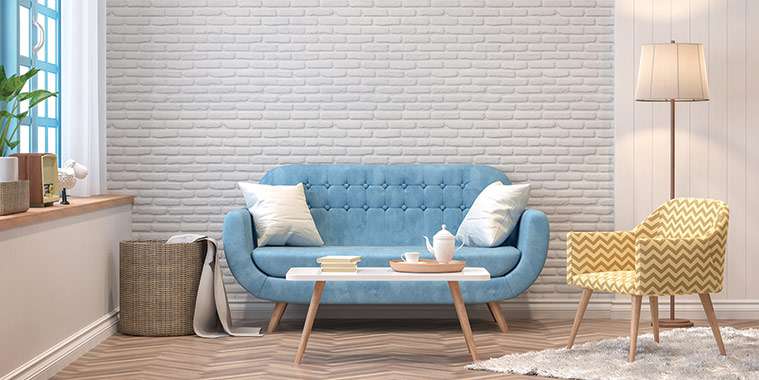In a perfect world, your living room should be a space for relaxing, entertaining, or playing with the kids — a one-stop shop to hide away from the worries of the day. So why do some of us end up avoiding this space at all costs?
It turns out, your living room decor choices (or lack thereof) could be stressing you out. Stop the tension in its tracks by making these easy design changes, which promise to smooth your mood and transform the space into the laid-back paradise you deserve.
1. Clutter
You had to know this would be the first thing we’d call out: It’s OK for your living room to look lived-in (it is in the name, after all). But too much “living” can leave a space looking like a junkyard. And, you guessed it: Mess and stress are psychologically linked.
“The living room is a notorious catchall and, as humans, we love to dump our stuff there,” says Leigh Spicher, the national director of design studios at Ashton Woods.
Spicher’s living room has “beautiful architectural finishes, large windows, and a glorious brick fireplace” — but she doesn’t notice those things. Instead, she sees the toddler toys, dog bones, shoes, remote controls, magazines, and more.
Improve your mood: Tuck away games and books in built-ins, and choose furniture with storage so you can easily keep odds and ends out of sight.
2. Sounds and smells
Clutter isn’t just visual. “It’s also found in other senses, such as noise and scent,” Spicher says.
Think about your living room: Do you have a Sonos and a television? Do your kids watch YouTube on their tiny screens while you’re watching “The Bachelorette” on the big screen? All that noise keeps you on edge and prevents relaxation — no matter how many glasses of rosé you down during the show.
Think beyond the audio, too: “Avoid numerous scents,” Spicher says, “especially unnatural scents, such as plug-ins.”
Improve your mood: Pick one primary scent — ideally a natural one, like your favorite potpourri — and make sure to play only one audio source at a time. Really, try it.
3. White fabrics
You might love the all-white look, but a living room isn’t always the best space for stark, minimal decor.
“Yes, we all want our living room to be nice and perhaps a bit more formal than the rest of the house,” says designer Mark Cutler. “But stay away from white fabrics or you’ll constantly be worried about spills and stains.”
Darker colors cover up messes and allow you to live in your living room — not just tiptoe through the space.
Improve your mood: Of course, if you can’t live without all-white decor, go for it. But consider your limits: Will you feel stressed out whenever a guest sips red wine or coffee? Are you willing to drop everything and scrub away whenever you spot the slightest bit of dirt? If not, consider a darker decor scheme.
4. Bare windows
Even if you’re tucked away deep in the woods, it’s hard to shake the spooky sense that you’re being watched when there’s nothing between you and nature.
Full-strength, unfiltered sunlight causes stress, too. (Think about your living room heating up with the afternoon sun, or not being able to see your TV due to a full-screen glare.) Covering up your windows returns your sense of control, and helps your living space feel private and personal.
Improve your mood: “Don’t skimp on blinds, curtains, and shades,” says Nicolette Powell, an interior designer at Oasis Rug & Home. “They bring style to a living room, and they’re functional.”
5. Artificiality
If you’ve been feeling a little on edge lately, take a look around your living room: Are you missing some greenery?
“If we omit natural elements in our living room, we are inviting stress in,” Spicher says.
Improve your mood: Add more plants. If you’re allergic to greenery or just not a fan of the look, there are a number of other options. Consider adding a small water element, like a fish tank, or starting a fire in the fireplace. Mixing natural elements throughout your decor — think stone, metal, and wood — adds that outdoorsy feel, too.
6. Lack of design
“Living rooms are often left as an afterthought and simply built as a big box,” Spicher says. But “if there’s one room in the home that needs design and organization — besides the kitchen — it’s the living room.”
So ditch the unadorned white walls and dull decor. But beware of designing for someone else, or blindly copying what you see on Pinterest. If you pick decor that doesn’t suit your lifestyle or tastes, you might feel like you’re occupying someone else’s space — and that can be downright stressful.
Improve your mood: Consider what makes you feel the most Zen. Comfortable couches? Bright colors? Bold patterns? Play it up. Craft a well-designed space that’s tailored to your desires, and turn a stressful, empty box into a retreat you adore.
— realtor.com



